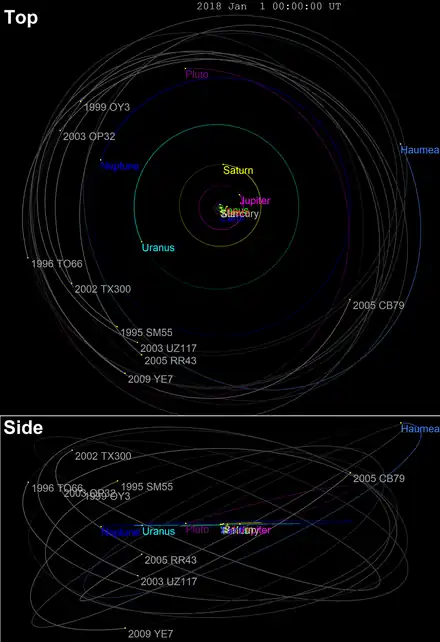_2003_SQ317_hst.jpg.webp) Hubble Space Telescope image of 2003 SQ317 taken in 2009 | |
| Discovery[1][2] | |
|---|---|
| Discovered by | CFEPS |
| Discovery site | Mauna Kea Obs. |
| Discovery date | 23 September 2003 (first observed only) |
| Designations | |
| 2003 SQ317 | |
| TNO[1] · cubewano[3] SCATEXTD[4] | |
| Orbital characteristics[1] | |
| Epoch 4 September 2017 (JD 2458000.5) | |
| Uncertainty parameter 4 | |
| Observation arc | 10.12 yr (3,698 days) |
| Aphelion | 45.746 AU |
| Perihelion | 39.231 AU |
| 42.489 AU | |
| Eccentricity | 0.0767 |
| 276.96 yr (101,159 days) | |
| 6.9467° | |
| 0° 0m 12.96s / day | |
| Inclination | 28.619° |
| 176.34° | |
| 191.81° | |
| Physical characteristics | |
| Dimensions | 300±150 km[5] |
Mean density | 0.8–2.7 g/cm3[6] |
| 7.210±0.001 h[6] 7.5 h[1] | |
| 0.05–0.50[6] | |
| B−R=1.05±0.18[6] | |
| 6.2[1] | |
(612620) 2003 SQ317 is a classical trans-Neptunian object and member of Haumea family from the Kuiper belt located in the outermost regions of the Solar System, approximately 300 kilometers in diameter. It was first observed on 23 September 2003, by astronomers of the Canada–France Ecliptic Plane Survey at Mauna Kea Observatories on Hawaii. The surface of 2003 SQ317 is made of water ice.[7]
Physical properties

2003 SQ317 is a classical Kuiper belt object (cubewano) belonging to the hot population. Its size estimated to lie between 150 and 450 km based on a range of plausible albedos. The object has a large light curve amplitude of about 0.85, which indicates that it has an extremely elongated shape or is a contact binary.[8] In the former case the density of 2003 SQ317 is estimated at 0.86 g/cm3 and its axis ratios at 0.55 and 0.41. If 2003 SQ317 is a contact binary, which is actually more likely, the density is estimated at 2.67 g/cm3. In the latter case, the components are also thought to be unequal in size with the mass ratio of about 0.3 and axis ratios of about 0.8 and 0.5, respectively, for the primary and secondary components.[6]
Origin
2003 SQ317 was identified as a member of the Haumea family, which is defined based on a common pattern of IR water-ice absorption, neutral visible spectrum and the clustering of the orbital elements. The Haumea family members including (19308) 1996 TO66, (55636) 2002 TX300, (120178) 2003 OP32, (145453) 2005 RR43 and others all appear to be collisional fragments broken off of the dwarf planet Haumea.[7]
See also
- (139775) 2001 QG298
- 2004 TT357
References
- 1 2 3 4 5 "JPL Small-Body Database Browser: (2003 SQ317)" (2012-10-20 last obs.). Jet Propulsion Laboratory. Retrieved 14 October 2017.
- ↑ "2003 SQ317". Minor Planet Center. Retrieved 14 October 2017.
- ↑ "MPEC P22: DISTANT MINOR PLANETS (2006 Aug. 23.0 TT)". IAU Minor Planet Center. 6 August 2006. Archived from the original on 25 February 2016. Retrieved 17 February 2016.
- ↑ Marc W. Buie. "Orbit Fit and Astrometric record for 03SQ317". SwRI (Space Science Department). Retrieved 17 February 2018.
- ↑ Dan Bruton. "Conversion of Absolute Magnitude to Diameter for Minor Planets". Department of Physics & Astronomy (Stephen F. Austin State University). Archived from the original on 23 March 2010. Retrieved 27 December 2009.
- 1 2 3 4 5 Pedro Lacerda; Andrew McNeill; Nuno Peixinho (2014). "The unusual Kuiper belt object 2003 SQ317". MNRAS. 437 (4): 3824–3831. arXiv:1309.1671. Bibcode:2014MNRAS.437.3824L. doi:10.1093/mnras/stt2180.
- 1 2 Snodgrass, Carry; Dumas, Hainaut (16 December 2009). "Characterisation of candidate members of (136108) Haumea's family". Astronomy and Astrophysics. 511: A72. arXiv:0912.3171. Bibcode:2010A&A...511A..72S. doi:10.1051/0004-6361/200913031. S2CID 62880843.
- ↑ "The Unusual KBO 2003 SQ317". 14 November 2013.
